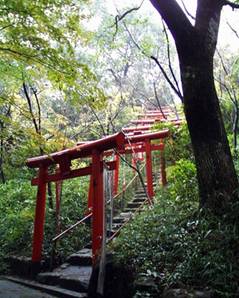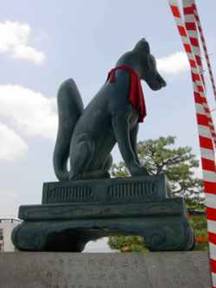Sisters of the Burning Branch Goddess Gallery Presents...
Inari & Her Kitsune
By Akasha Kitsune (as is 1st picture!)
Inari,
or Oinari, is
said to have roots in ancient Hindu mythology, although longer has been
and is
revered as a Japanese Shinto kami,
or
deity. Stories of Inari in Japan
have
been traced back conclusively to 892 AD and many shrines still exist.
Inari is
variably depicted as a beautiful young woman riding a white fox or an
old man,
depending upon the situation and time in history. Every source I found
agreed
that the history of Inari was complex and changing. In other myths,
Inari is
actually the name
of a collective of three to five kami, or deities, who could
better explain the various versions and depictions of Inari over time.
Some
theorize that the Buddhist influence changed the original goddess’s
image into
a male. Most modernly the woman figure has become most popular, so I’ll
stick
with referring to Inari as “her” to avoid confusion. Mainly known as
goddess of
food and rice, and abundance in general, Inari is very important to the
survival of her people. She not only protects and preserves rice
harvests, but
is patroness of farmers and merchants ranging from general foodstuffs
to
fisheries.
Shape-shifting
fox spirits, or kitsune, act as messengers of Inari and
serve as guardians to portals, in this world and otherwise. Usually a
pair of
kitsune statues flank an image of Inari and it is still not uncommon to
see
kitsune statues at the gates of cities, shrines and stores. Kitsune
appear as
foxes, but it is noteworthy that they have more than one tail, up to
nine, and
the more they have the older and more powerful they are. Inari’s image
herself
as god or goddess has most recently faded and intermingled with the
kitsune
once said to serve her. Since they are shape-shifters, the kitsune
themselves
have been revered as the god/dess and the fox overall is honored since
it may
be Inari in disguise. Patriarchal systems thus have tried to make the
kitsune sinister
and even the term vixen has been used derogatorily describing females,
but they
are merely clever and playfully tricky, often acting so as to test
those
claiming to worship the goddess. Kitsune modernly are also popular in
anime
and sci-fi/fantasy
games. Since I’d been given that surname years ago, this
especially surprised me !
.
.
 One
legend I’ll recap
briefly if I can manage
it here. A wealthy
lord grew
tired of
the foxes roaming his land
so ordered a
fox hunt.
His wife, a
beautiful young woman, tried to persuade him otherwise, that he had
enough land
to share with other creatures of nature, but the man had become greedy
and
selfish as his wealth had grown. One morning early his men had declared
success, and came home with a dead vixen
and crate of five kits. The lord
announced a great feast to celebrate, and ordered the kits
exterminated. One
of
his men, however,
could not bear
to kill the young animals so set them free in
the neighbouring lord’s
land. Once free,
he was astonished to see the kits
transform into the lord’s five daughters. Four
left in disgust, but the fifth
agreed to become his wife, so returned with him to her father’s land.
Upon arrival,
she declared her father a murderer and then the body of her mother was
found
carelessly discarded behind the main building. The lord was stripped of
all his
riches and arrested while his daughter and the rebellious
hunter gained power
of his lands. When the new lord asked his new wife what had
happened, she
explained to him that Inari had greatly blessed her father and he
betrayed her,
killing her daughters the kitsune, so suffered for his selfishness.
One
legend I’ll recap
briefly if I can manage
it here. A wealthy
lord grew
tired of
the foxes roaming his land
so ordered a
fox hunt.
His wife, a
beautiful young woman, tried to persuade him otherwise, that he had
enough land
to share with other creatures of nature, but the man had become greedy
and
selfish as his wealth had grown. One morning early his men had declared
success, and came home with a dead vixen
and crate of five kits. The lord
announced a great feast to celebrate, and ordered the kits
exterminated. One
of
his men, however,
could not bear
to kill the young animals so set them free in
the neighbouring lord’s
land. Once free,
he was astonished to see the kits
transform into the lord’s five daughters. Four
left in disgust, but the fifth
agreed to become his wife, so returned with him to her father’s land.
Upon arrival,
she declared her father a murderer and then the body of her mother was
found
carelessly discarded behind the main building. The lord was stripped of
all his
riches and arrested while his daughter and the rebellious
hunter gained power
of his lands. When the new lord asked his new wife what had
happened, she
explained to him that Inari had greatly blessed her father and he
betrayed her,
killing her daughters the kitsune, so suffered for his selfishness.
Foxes
in general, especially white and silver, are
sacred to Inari. It was an interesting find that the Cherokee word
“inari”
means gray fox. Her often sought after prize and symbol is a
wish-fulfilling
jewel. Sheathes or bags of rice are often seen at her side, and the
sickle and
a white sword are also often depicted in her grasp. Another of her
belongings
is a great whip said to be used to lash out and burn crops of those who
have
crossed her. Her temples are still too numerous to count. People visit
them for
prosperity, a bountiful harvest, success in business, and safety in
crossing
the sea. The deep red shrines and arches, called torii, that
still cross Japan are sacred to her, as are mountains. Inari sushi is
also popular still, named so because, mainly, its triangular and
resembling a
fox head. The symbol hoshu-no-tama, a pear-shaped emblem surmounted by
flames,
is also related to her.

(can light white candle & put a few grains of rice on altar, as well as have a figure of a fox or dog)
“Great
goddess Inari I thank you for
the blessings & abundance already in my life. Let me be mindful
daily of
your presence & gifts in this world.
Bless me further with growth
in
<whatever you need here> & let my home be safe, always full
of food,
fun & reverence. Blessed be!”
By
Akasha Kitsune


Above is an Inari shrine found in a cave, age unknown.
Sources: Foxtrot’s Research on Kitsune Lore by Kit Lahaise
The Kitsune Page at www.coyotes.org
Japanese kami section in my grimoire Terra from my grandmother
Information
from my priestess sister Mitoko in
Kamakura